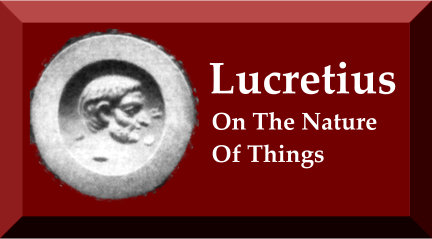A Few Thoughts On Reading Lucretius
“On The Nature of Things” can seem very tedious to the modern reader in its discussion of atoms and void, and the poem can get even more confusing when the reader gets to the parts on ‘images.’
Just remember that the purpose of the atom and void discussion is to show you how the universe can and does operate through natural principles, on its own, and without the creation or intervention of any supernatural gods. It also innoculates you against not only religion but also against “idealism” of the Platonic and Aristotelian varieties. By focusing on “nothing exists eternally except atoms and void’ (and the “eternally” is key) it becomes nonsensical to postulate that “ideal forms” exist eternally somewhere out there (Plato) or that eternal “essences” exist within things which endow them with some mystical nature that we can label into categories (Aristotle). These are the key proponents of otherworldly arguments of all kinds (including the argument that there is an absolute “virtue”), and so the atom and void discussion, once understood and followed to its logical conclusion, makes those positions impossible to believe..
As for “images” I think even fewer people get through that part than the atoms and void. When you get there, remember that nothing else in the book matters if we can’t establish with confidence that some things are true and some things are false. Lucretius does not spend much time formally discussing the three legs of the canon, but he does spend a lot of time on the five senses and how that leg of the canon is essential to determining anything with confidence. And in order to have confidence in the senses we must know how they operate, and that they do not operate magically directed by gods or ideals or by essences. Rather, they operate by contact with this up close (touching tasting) and further away (seeing, hearing, smelling) because there is flowing through the “air” around us atoms which move from them to us (and vice versa). Epicurus described the movement of these atoms as “images” carrying information about the things around us that our senses can then pick up and process.
It is important to consider how these images operate because we know that the information they carry (not a good way to say it, but shorthand) can get distorted as is travels toward us, and that’s why things at a distance look blurry, smaller, etc. In other words, Epicurus knows the obvious truth that just because we perceive something in a certain way (color, size, etc) we don’t know for sure at first glance that our conclusion about the thing is accurate. We have to account for distortions of space and intervening interference in order to process the sensations we receive and assemble them into a conclusion in which we can have confidence.
That’s why the discussion about images (chapter 5, I think) is so important – we know mistakes are possible, so we have to be confident that we can study the senses and process the information properly so as to make good judgments and correct the errors that occur.
Many modern commentators seem to dismiss all this as quaint irrelevance and antiquated because they don’t address why all this is important (and frequently they are total skeptics themselves and don’t care to address with sympathy anyone who claims that knowledge is possible.)

